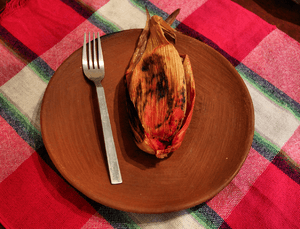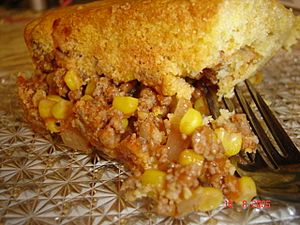Tamale facts for kids
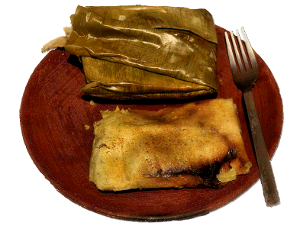
|
|
| Course | Main course |
|---|---|
| Place of origin | Mesoamerica |
| Region or state | North America |
| Main ingredients | Corn (maize) masa, banana leaves |
| Variations | Corunda, Guajolota, Uchepos, Zacahuil |
| Similar dishes | Humitas, pamonha |
A tamale is a yummy traditional dish from Mesoamerica. It's made from a special dough, usually from corn, called masa. This dough is steamed inside a corn husk or a banana leaf.
You can take off the wrapping before you eat it, or use it like a plate. Tamales can have all sorts of fillings! People put meats, cheeses, fruits, veggies, or chilies inside. You can also season the filling and the cooking liquid to make them taste even better.
The word tamale comes from the Spanish word tamal. The Spanish word comes from the Nahuatl word tamalli.
Contents
What is a Tamale?
A tamale is a delicious meal wrapped in a natural leaf. It's like a little package of flavor! The main part is a dough made from corn, called masa. This dough is soft and starchy.
People steam the tamale until it's firm. The wrapping keeps it moist and adds flavor. It's a very old and important food.
Where Did Tamales Come From?
Tamales first appeared in Mesoamerica a very long time ago. This was around 8000 to 5000 BC. That's even before ancient Egypt!
Experts think tamales started in Mexico and Guatemala. Then, the idea of making them spread across Latin America. Pictures of tamales have been found in ancient art. Some date back to 100 AD in Guatemala.
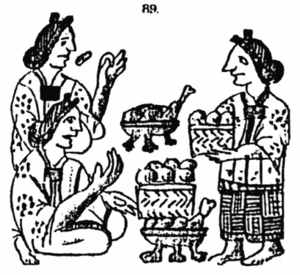
The Aztecs and Maya people used tamales. So did the Olmec and Toltec civilizations. They were great for hunting trips and long journeys. Armies also ate them because they were easy to carry.
Tamales were also considered sacred. People thought they were food for the gods! These ancient groups believed they were "people of corn." So, tamales were a big part of their special events and celebrations.
Tamales in Mexico
Mexico is a place where tamales are very popular. They have a long history there.
Ancient Mexican Tamales
Maya Tamales
Long ago, the Mayas ate tamales at their feasts. We know this from pictures on old pots. These pictures are from 200–1000 CE.
Back then, tamales might have been the main food. They were cooked without special ceramic tools. This means tamales might be even older than tortillas! Both foods use corn dough.
Aztec Tamales
The Aztecs also ate tamales. Their tamales had many different fillings. These included turkey, fish, and even frogs! They also used honey, fruits, and beans.
Aztec tamales were different from today's. They didn't have added fat. This made them a bit less fluffy.
One special Aztec event was the Atamalcualiztli feast. This happened every eight years. For a whole week, people ate plain tamales. They had no seasoning or filling. This was to give the corn a "rest" from being overworked.
Modern Mexican Tamales

Today in Mexico, tamales start with a special corn dough. This dough is called masa. It's mixed with lard or vegetable shortening. Then, broth or water is added. This makes a thick batter.
People often whisk the lard and batter. This makes the tamales soft and fluffy. Some recipes use baking powder for the same effect. Chili can be added to the batter. This gives some tamales a red color and a spicy kick.
Tamales are usually wrapped in corn husks. In tropical areas, plantain leaves are used. They are steamed until they are firm.
Making tamales is a special tradition in Mexico. It has been since ancient times. Different fillings were used for different festivals. Today, tamales often have meat, cheese, or chilies.
Making them takes a lot of time. It's often a group effort, usually by women. Tamales are a favorite comfort food. People eat them for breakfast or dinner. They often have them with hot drinks like atole.
You can find street vendors selling tamales. They serve them from big, steaming pots. These pots are called tamaleras.
In places like Oaxaca or Yucatán Peninsula, banana leaves are common. These tamales are often square and very large. Some are 15 inches long! The big ones in Yucatán are called "pibs."
Another huge tamale is zacahuil. It's made in the Huasteca region. A zacahuil can feed 50 to 200 people! They are made for festivals and holidays.
Tamales in Guatemala
Guatemala also has a rich history with tamales.
Ancient Guatemalan Tamales
In ancient times, the Maya lords in Guatemala enjoyed a baked corn bun. This was during the winter solstice. It was made with corn, turkey, or venison. Spices and chili peppers were also added.
Modern Guatemalan Traditions
This ancient meal became part of modern traditions. For example, on Christmas Eve, families make tamales. They share them with friends to show thanks. Tamales are often eaten with chocolate and punch.
It's common to eat tamales at midnight on December 24 and 31. Guatemalans also use tamales for birthdays and baptisms. Tamales are a very important dish in Guatemala's culture.
Guatemala has many types of tamales. There are traditional corn husk tamales, called "chuchitos." There are also sweet tamales. These use corn dough with honey or sugar. They might have chocolate, almonds, or plums.
You can buy tamales all over Guatemala. A red light on a house at night means tamales are for sale!
Guatemalan Tamale Varieties
- Red tamales get their color from achiote and tomato. They have corn dough and are filled with chicken, beef, or pork. They are wrapped in banana leaves.
- Cambray tamales have raisins and almonds.
- Sweet tamales have a sweet filling.
- Black tamales get their name from the chocolate in them.
- Chuchito is a very famous Guatemalan dish. It's a tamale with firmer corn dough. It often has a tomato sauce and chicken, beef, or pork. It's wrapped in dried corn leaves.
- Rice tamales come from the highlands. They use rice dough instead of corn dough.
- Paches are tamales from the highlands. They use potato instead of maize for the dough.
- Tamal or tamalito is just the dough. It has no meat or other fillings. People eat it with a meal to scoop up food.
Tamales in Belize
In Belize, tamales are a main food. They are also known as dukunu. This is a green corn tamale.
Tamales in the Caribbean
Tamales are also found in many Caribbean countries.
Cuba
In Cuba, street vendors used to sell Mexican-style tamales. These were wrapped in corn husks. They usually weren't spicy. A famous Cuban song from the 1950s, "Los Tamalitos de Olga", celebrated delicious tamales.
A special Cuban dish is tamal en cazuela. This is like a hearty cornmeal porridge. The tamale dough and meat filling are cooked together in a pot.
Dominican Republic
In the Dominican Republic, guanimo are Dominican tamales. They are filled with picadillo, which is a seasoned ground meat. The name guanimo comes from the native Taíno people.
Puerto Rico
Guanime is a Puerto Rican dish. It's very old, from before Europeans arrived. It's made of corn masa. It used to be stuffed with beans, seafood, or meat. Then it was wrapped in corn husks and cooked.
Today, guanimes are often plain. They are served with stewed salted cod fish. They can also be made with green plantains or cassava. There's even a sweet version with sweet plantains.
Guanimes are related to pasteles. Pasteles are a root vegetable tamale.
Trinidad and Tobago
In Trinidad and Tobago, tamales are called pastelle. They are very popular during Christmas and New Year. They are made with cornmeal. They are filled with seasoned meat, raisins, and olives.
The pastelle is wrapped in a banana leaf. Then it's tied with string and steamed. When cooked, the leaf is removed. It shows a bright yellow dish. A sweet version is called paymee.
Tamales in the United States
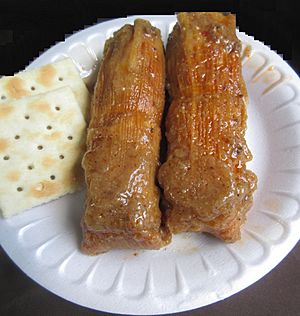
Tamales have been eaten in the United States since at least 1893. They were shown at the World's Columbian Exposition that year. In 1894, tamales were very popular in Los Angeles. A company called XLNT started making them. It's one of the oldest Mexican food brands in the US.
Traveling tamale sellers were common in the early 1900s. They were even mentioned in blues music. The famous 1937 song "They're Red Hot" by Robert Johnson is about them.
Besides Mexican-style tamales, the US has its own types.
The Choctaw and Chickasaw tribes make a dish called banaha. It can be plain or stuffed. Fillings include bacon, turkey, or vegetables. It's steamed in a corn shuck.
Cherokee tamales are also called bean bread. They were made with hominy and beans. They were wrapped in green corn leaves and boiled. These were similar to ancient meatless tamales.
In the Mississippi Delta, African Americans made a spicy tamale. It uses cornmeal instead of masa. It's boiled in corn husks. This is sometimes called a "hot tamale."
In northern Louisiana, tamales have been made for centuries. Spanish settlers from Mexico brought the tradition. Zwolle, Louisiana, even has a Tamale Fiesta every October!
Around the 1900s, "tamale pie" became popular. This is a casserole with a cornmeal crust. It has typical tamale fillings in layers. It's seen as Mexican food, but it's not common in Mexican American culture. They prefer the individually wrapped tamales.
The Indio International Tamale Festival is held every December. It's in Indio, California. It has two Guinness World Records! It's the largest tamale festival. It also made the world's largest tamale. It was over 1 foot wide and 40 feet long!
Tamales in the Philippines and Guam
In the Philippines and Guam, different kinds of "tamales" exist. These places were once governed by Spain as part of Mexico.
In the Philippines, tamales mixed with local leaf-wrapped rice cakes. These are called kakanin. They are made with ground rice dough. They are filled with seasoned chicken or pork. Peanuts and sugar are also added.
Some tamales in the Philippines are wrapped in banana leaves. Others are wrapped in corn husks. Because they take a lot of work, tamales usually appear during holidays. Many old tamale recipes have disappeared over time.
There are many kinds of tamales in the Philippines. Some are sweet, some are savory, and some are both. Most are wrapped in banana leaves. They are made of rice cooked with coconut milk. They can have meat or seafood, or be plain.
Some types, like tamalos, are made of sweet corn masa. They are wrapped in a corn husk. Other types, like tamalis, have no masa. They are made with small fish wrapped in banana leaves and steamed.
The tamales found in Guam are called tamales guiso. They are made with corn masa and wrapped in corn husks. This shows the influence of trade between Manila and Acapulco.
Images for kids
See also
 In Spanish: Tamal para niños
In Spanish: Tamal para niños


